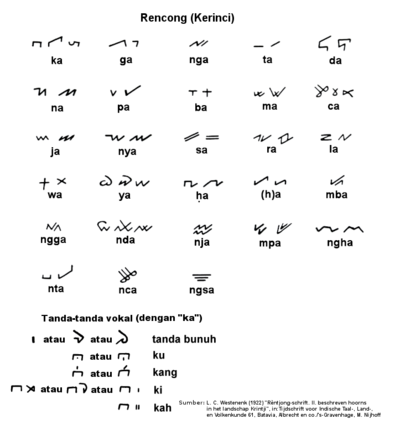
Rencong script
Encyclopedia
]
 Rencong script is a writing system used to write Malay
Rencong script is a writing system used to write Malay
in Sumatra (Kerinci, Bengkulu
, Palembang
and Lampung
). The script lasted until the 18th century which was before the Dutch colonised Indonesia
. It was gradually replaced by the Jawi script, a slightly modified Arabic script.
The Malay
used Rencong or Rencang script, Kawi script and Lampung script in ancient times. Studies showed that these writings are related to the ancient Cambodian writings. The script is also related to the Batak script.
Rencong script was written on tree bark
, bamboo
, horn
s and palmyra-palm
leaves.

Malay language
Malay is a major language of the Austronesian family. It is the official language of Malaysia , Indonesia , Brunei and Singapore...
in Sumatra (Kerinci, Bengkulu
Bengkulu
Bengkulu is a province of Indonesia. It is on the southwest coast of the island of Sumatra, and borders the provinces of West Sumatra, Jambi, South Sumatra and Lampung. The capital and largest city is Bengkulu city. It was formerly the site of a British garrison, which they called Bencoolen...
, Palembang
Palembang
Palembang is the capital city of the South Sumatra province in Indonesia. Palembang is one of the oldest cities in Indonesia, and has a history of being a capital of a maritime empire. Located on the Musi River banks on the east coast of southern Sumatra island, it has an area of 400.61 square...
and Lampung
Lampung
Lampung is a province of Indonesia. It is located on the southern tip of the island of Sumatra and borders the provinces of Bengkulu and South Sumatra. Lampung is the original home of the Lampung people, who speak a distinct language from other people in Sumatra and have their own alphabet. Its...
). The script lasted until the 18th century which was before the Dutch colonised Indonesia
Indonesia
Indonesia , officially the Republic of Indonesia , is a country in Southeast Asia and Oceania. Indonesia is an archipelago comprising approximately 13,000 islands. It has 33 provinces with over 238 million people, and is the world's fourth most populous country. Indonesia is a republic, with an...
. It was gradually replaced by the Jawi script, a slightly modified Arabic script.
The Malay
Malay people
Malays are an ethnic group of Austronesian people predominantly inhabiting the Malay Peninsula, including the southernmost parts of Thailand, the east coast of Sumatra, the coast of Borneo, and the smaller islands which lie between these locations...
used Rencong or Rencang script, Kawi script and Lampung script in ancient times. Studies showed that these writings are related to the ancient Cambodian writings. The script is also related to the Batak script.
Rencong script was written on tree bark
Bark
Bark is the outermost layers of stems and roots of woody plants. Plants with bark include trees, woody vines and shrubs. Bark refers to all the tissues outside of the vascular cambium and is a nontechnical term. It overlays the wood and consists of the inner bark and the outer bark. The inner...
, bamboo
Bamboo
Bamboo is a group of perennial evergreens in the true grass family Poaceae, subfamily Bambusoideae, tribe Bambuseae. Giant bamboos are the largest members of the grass family....
, horn
Horn (anatomy)
A horn is a pointed projection of the skin on the head of various animals, consisting of a covering of horn surrounding a core of living bone. True horns are found mainly among the ruminant artiodactyls, in the families Antilocapridae and Bovidae...
s and palmyra-palm
Borassus flabellifer
Borassus flabellifer, the Asian Palmyra palm, Toddy palm, Sugar palm, or Cambodian palm, is native to South and Southeast Asia, in the Indomalaya ecozone...
leaves.
See also
- Rejang scriptRejang scriptThe Rejang script, sometimes spelt Redjang and locally known as Surat Ulu , is an abugida of the Brahmic family, and is related to other scripts of the region, like Batak, Buginese, and others. Rejang is a member of the closely related group of Surat Ulu scripts that include the script variants of...

